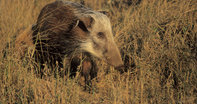
Name:
Bushpig (potamochoerus larvatus)Appearance
The bush pig is a stocky, strong pig with powerful forequarters. An adult boar measures about 900 mm at the shoulder and weighs as much as 60 kg. It has short, sharp lower tusks that grow to 7 cm in length, and its small upper tusks are hardly visible.
The bush pig can be very dangerous when taken by surprise in the bush, or when wounded. It can inflict serious wounds with razor-sharp protruding canines.
Bush Pig Diet
Bush pigs are well known for their crop raiding abilities and are regarded by some farmers as a pest. They thrive in living close to human settlements due to their liking of agricultural crops such as potatoes, maize, sugarcane, tomatoes and other vegetables.
In the wild, bush pigs feed on plant roots, insect larvae, fruits, tubers and rhizomes which they root from the subsurface soil.
Bush Pig Behaviour
Bush pigs are the largest animals in sub-Saharan Africa to build nests. Sows bite off grass and gather the bushels into a heap measuring up to three metres across and one metre high, not unlike a small haystack when completed.
The sows leave her piglets in the care of the dominant boar, yet still suckles them. When piglets are introduced to the rest of the group, the boar takes on the role of their protector.
Piglets remain with the group for the first six months of their life and are then removed from the group by the dominant pair. Bush pigs are strong swimmers and do not hesitate to wade into a water to reach plants. Of course, they enjoy rolling in mud to cool down.
 Bush pigs (Potamochoerus larvatus) are found from the northern and eastern parts of South Africa from southern KwaZulu-Natal, the interior o...
Bush pigs (Potamochoerus larvatus) are found from the northern and eastern parts of South Africa from southern KwaZulu-Natal, the interior o... Learning about the mammals of South Africa is now so much easier for all South Africans - SouthAfrica.co.za is an excellent source of inform...
Learning about the mammals of South Africa is now so much easier for all South Africans - SouthAfrica.co.za is an excellent source of inform...